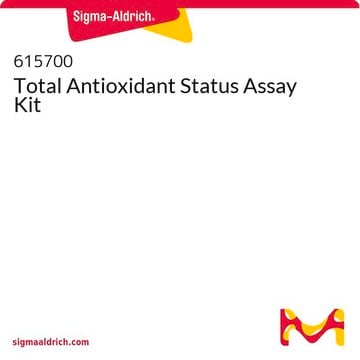CS0790
Antioxidant Assay Kit
sufficient for 200 tests
Synonym(s):
Oxidative Stress Detection Kit
Sign Into View Organizational & Contract Pricing
All Photos(3)
About This Item
UNSPSC Code:
12161503
NACRES:
NA.84
Recommended Products
usage
sufficient for 200 tests
Quality Level
detection method
colorimetric
shipped in
wet ice
storage temp.
2-8°C
General description
Free radicals or reactive oxygen species (ROS) are produced during biochemical redox reactions as part of normal physiological cell metabolism (protection from infectious organisms) and as a response to environmental factors such as UV light, cigarette smoke, environmental pollutants, and g-radiation. Once formed, ROS attack cellular components causing damage to lipids, proteins, and DNA, which can initiate numerous diseases, including cancer, atherosclerosis, rheumatoid arthritis, diabetes, liver damage, and central nervous system disorders.
In the presence of antioxidants the radical cation is suppressed to an extent dependent on the activity of the antioxidant and the color intensity is decreased proportionally. Trolox, a water-soluble vitamin E analogue, serves as a standard or a control antioxidant.
Application
Antioxidant assay kit provides all of the reagents required for an efficient measurement of the total antioxidant capacity of plasma, serum, urine, saliva, cells, and tissue lysates. It has also been used to measure the radical cation (2,2′-azino-di-[3-ethylbenzthiazoline sulphonate]) (ABTS+) scavenging capacity.
It was tested on A431 and CHO cell lysates; rat brain, liver, and kidney lysates; human plasma, serum, urine, and saliva.
Suitability
Suitable for the measurement of the total antioxidant capacity of plasma, serum, urine, saliva, cells, and tissue lysates
Principle
The principle of the antioxidant assay is formation of a ferryl myoglobin radical from metmyoglobin and hydrogen peroxide, which oxidizes the ABTS (2,2¢-azino-bis(3-ethylbenzthiazoline-6-sulfonic acid) to produce a radical cation, ABTS·+ , a soluble chromogen that is green in color and can be determined spectrophotometrically at 405 nm.
Preparation Note
Reagents are to be prepared with ultrapure water.
Reconstitution
Myoglobin Solutions are to be stored at -20C after reconstitution.
Trolox Working Solution is to be stored at -20C after reconstitution.
ABTS Substrate Solution is to be stored at 4C for 2 weeks or at -20C for 1 month.
Trolox Working Solution is to be stored at -20C after reconstitution.
ABTS Substrate Solution is to be stored at 4C for 2 weeks or at -20C for 1 month.
Legal Information
Kit Components Only
Product No.
Description
- Assay Buffer 10X 30 mL
- Stop Solution 20 mL
- Hydrogen Peroxide, 3% solution 1 mL
- Myoglobin from horse heart 2 x 1
- (±)-6-Hydroxy-2,5,7,8-tetramethylchromane-2-carboxylic acid (Trolox®) 2 x 1
- ABTS, 10 mg tablets 4 tab
- Phosphate-Citrate Buffer, pH 5 4 tab
related product
Product No.
Description
Pricing
Signal Word
Danger
Hazard Statements
Precautionary Statements
Hazard Classifications
Acute Tox. 4 Oral - Aquatic Chronic 3 - Eye Dam. 1 - Skin Irrit. 2 - STOT SE 3
Target Organs
Respiratory system
Storage Class Code
10 - Combustible liquids
WGK
WGK 3
Flash Point(F)
Not applicable
Flash Point(C)
Not applicable
Certificates of Analysis (COA)
Search for Certificates of Analysis (COA) by entering the products Lot/Batch Number. Lot and Batch Numbers can be found on a product’s label following the words ‘Lot’ or ‘Batch’.
Already Own This Product?
Find documentation for the products that you have recently purchased in the Document Library.
Customers Also Viewed
Reversal of hepatic steatosis by omega?3 fatty acids measured non?invasively by 1H?magnetic resonance spectroscopy in a rat model.
Marsman HA, et al.
Journal of Gastroenterology and Hepatology, 26(2), 356-363 (2011)
Dave C Francisco et al.
Free radical biology & medicine, 44(4), 558-569 (2007-11-17)
Oxidatively induced stress and DNA damage have been associated with various human pathophysiological conditions, including cancer and aging. Complex DNA damage such as double-strand breaks (DSBs) and non-DSB bistranded oxidatively induced clustered DNA lesions (OCDL) (two or more DNA lesions
Use of sourdough fermentation and pseudo-cereals and leguminous flours for the making of a functional bread enriched of γ-aminobutyric acid (GABA).
Coda R, et al.
International Journal of Food Microbiology, 137(2), 236-245 (2010)
Grit Kasper et al.
Stem cells (Dayton, Ohio), 27(6), 1288-1297 (2009-06-06)
Progenitor cells such as mesenchymal stem cells (MSCs) have elicited great hopes for therapeutic augmentation of physiological regeneration processes, e.g., for bone fracture healing. However, regeneration potential decreases with age, which raises questions about the efficiency of autologous approaches in
Muhammad Arshad et al.
Plant science : an international journal of experimental plant biology, 258, 122-136 (2017-03-24)
Alfalfa (Medicago sativa) is an important forage crop that is often grown in areas that frequently experience drought and water shortage. MicroRNA156 (miR156) is an emerging tool for improving various traits in plants. We tested the role of miR156d in
Our team of scientists has experience in all areas of research including Life Science, Material Science, Chemical Synthesis, Chromatography, Analytical and many others.
Contact Technical Service









